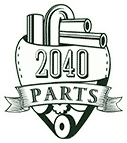The Isuzu 4X series engines were revolutionary for the time they were introduced. Isuzu included several technological innovations that were not common to production automobile engines at the time, and would not be adopted industry wide by other automobile manufacturers for as many as 20 years later. These innovations included forged connecting rods, Tufftride Ferritic Nitrocarburized hardening of the crankshaft, and "Rare Metal" Connecting Rod Bearings and Main Bearings. Isuzu's Japanese marketing capitalized on these innovations and the award winning power-per-unit-of-displacement 4XE1 engine, but these details are all but unknown outside of Japan.
Tufftride Ferritic Nitrocarburizing is a trademarked name for a patented process of applying a .005 inch thick hardened surface to untreated steel by bonding nitrogen compounds to the metal surface in a very hot cyanide bath. This process provides exceptional surface hardness without the risk of warpage that is common with heat treating. But the layer of hardened coating is microscopically thin, can wear through, is easily damaged if scratched, and is not sufficiently thick enough that any coating will be left if someone decides to grind or polish the journals. As a result of this, Isuzu did not offer undersized bearings for these engines. In the event that one or more of the crankshaft main journals and/or rod journals (also called rod pins) were damaged sufficient to scratch through the coating or to require grinding or resurfacing, the factory instructions are to discard the damaged crankshaft and obtain a new one.
Because the forged connecting rods were difficult and expensive to precision bore, Isuzu did make three different OD sizes of connecting rod bearings, as designated by the Roman Numerals I (1), II (2), and III (3). Roman Numeral II (2) was standard bore (48.988-48.883 mm / 1.9287-1.9288 inch). Roman Numeral I (1) was slightly undersized in OD while Roman Numeral III (3) was slightly oversized in OD. (The Inside Diameter of all three bearing variations was the same). The vast majority of connecting rods used in these engines were Roman Numeral II (2), or standard size.
The "Rare Metal" material is a reference to the use of an exotic metal element and alloy in the crank shaft and connecting rod bearings of the engine to reduce friction, improving wear resistance, and protection of the Tuffride coating on the crankshaft. It is difficult to find a direct translation and definition of the phrase "レアメタル". One translation indicates the English translation to be "Minor Metal", a group which includes Gallium, Cadmium, Molybdenum, Chromium, Vanadium, and Titanium, used extensively in electronics, power transfer, structural, and performance applications. The other translation indicates the meaning to be "Rare Earth Element", referring to the Lanthanide Elements, which include magnets and catalysts, and are in high demand for electronics. Both of these groups of elements and minerals are primarily found in China, are in high demand for everything from cell phone batteries to semiconductors, and the Chinese government has limited exports to keep commercial profits high and corner the market for production of products using these materials. Aftermarket bearing manufacturers do not use these materials, and instead offer a lower quality product that is basically a steel backing with an aluminum face.
Be Aware:
Reground and untreated crankshafts, and the use of poor quality bearings, are two primary causes of spun bearings in these engines.
These New OEM Connecting Rod Bearings are standard size Roman Numeral II (2). These bearings should be used with an OEM spec crankshaft in good, usable condition, and with Roman Numeral II (2) connecting rods.
Do not attempt to use these bearings with a reground or altered crankshaft which does not conform to the standard connecting rod journal diameter and width.
Do not ask if these bearings are available in underbore sizes. Underbore sizes do not exist.
For best results, use only Roman Numeral II (2) connecting rods.
If you have a damaged, reground, or altered crankshaft, you have bigger problems than not being able to find bearings, because you will need to find a usable OEM spec crankshaft or have your crank shaft restored to OEM spec before worrying about finding bearings. As of 2011, the price for an OEM crankshaft was $1,105.79 (4XE1) or $1,226.78 (4XF1), if available. Restoring a crank shaft to OEM spec involves welding the journals, regrinding the journals to OEM diameters, rebalancing the crank shaft, having the crank shaft nitride coated, and finally having the crank journals polished to OEM diameter to correct for the thickness added by the nitride coating process.
 New oem con rod bearings; 4xe1 1.6l dohc turbo lotus elan m100 isuzu impulse(US $434.99)
New oem con rod bearings; 4xe1 1.6l dohc turbo lotus elan m100 isuzu impulse(US $434.99) Mazdaspeed 3 6 ms6 ms3 cx-7 2.3l l3k9 mzr turbo engine crankshaft crank oem(US $289.99)
Mazdaspeed 3 6 ms6 ms3 cx-7 2.3l l3k9 mzr turbo engine crankshaft crank oem(US $289.99) Corvette 1969 quadrajet carburetor rodchester 350 350hp 4 speed q jet chevy
Corvette 1969 quadrajet carburetor rodchester 350 350hp 4 speed q jet chevy 2.5 nissan altima / sentra 02-07 harmonic balancer free kwik ship(US $39.70)
2.5 nissan altima / sentra 02-07 harmonic balancer free kwik ship(US $39.70) Engine harmonic balancer dorman 594-387(US $62.19)
Engine harmonic balancer dorman 594-387(US $62.19) Oem crankshaft position sensor for hyundai genesis coupe 2.0l turbo 2009-2014(US $39.90)
Oem crankshaft position sensor for hyundai genesis coupe 2.0l turbo 2009-2014(US $39.90)
